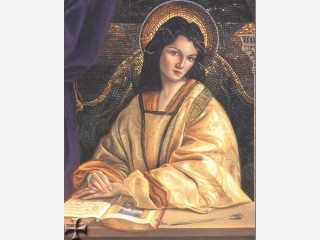
Anna Comnena biography
Date of birth : -
Date of death : -
Birthplace : Constantinopole
Nationality : Byzantine
Category : Historian personalities
Last modified : 2010-12-06
Credited as : Byzantine princess and scholar, author of Alexiad, daughter of the emperor Alexius I
The Byzantine princess and historian Anna Comnena was one of the major court figures of the Comneni period. She was the author of the Alexiad, a history of her father's reign.
Anna Comnena was the oldest daughter of the emperor Alexius I, a member of the military aristocracy who seized Constantinople and the throne in 1081, and Irene Ducas. Comnena was born in the room reserved for imperial infants and entered the world as heiress to the throne. At an early age she was betrothed to Constantine Ducas, son of Michael VII and a cousin in her mother's family, who also had a claim to the crown. In 1088 a son, John, was born to Irene and Alexius; and as the male heir, the rights of succession were soon transferred to him. Comnena never reconciled herself to this turn of fortune's wheel, and she nurtured a pathological hatred of her younger brother. A second blow to her ambitions was the premature death of her fiance.
Anna entered into a conspiracy with her mother against John. In 1097 she married Nicephorus Bryennius, a competent commander who took part in the Byzantine defense in the First Crusade, and a pretender to the throne. This man then joined mother and daughter in an attempt to convince Alexius to disinherit his eldest son. It is well known that at various times in Byzantine history imperial court politics were dominated by strong-minded women, and the reign of Alexius was such a time. Comnena took her place beside Maria, the mother of Constantine Ducas, and Anna Dalassena, the Emperor's forceful mother, as a member of the circle that exerted extraordinary influence. Alexius, however, withstood the assault, although even on his deathbed Comnena tried to make Alexius change his mind.
John moved quickly to have himself proclaimed emperor on his father's death in 1118. Such was Comnena's rancor and her obsession with her brother's success that she made an attempt on his life. It failed; John pardoned her and Comnena came to terms with the situation. She spent her final years in a convent. "I mostly keep in a corner," she wrote, "and occupy myself with books and God."
Comnena's reputation rests upon the history of her father's life and reign, the Alexiad, which she completed many years after his death. It is the chief source for this dynamic period in Byzantine history. Comnena was a capable historian. Her high position allowed her access to information that would ordinarily never have been known, and her intelligent handling of a vast amount of material makes an engaging narrative. Her classical instruction is apparent in her references to Homer, Plato, Aristotle, and Euripides, and in her use of heroic figures such as Achilles and Heracles to portray the virtues of valor and prowess among her contemporaries. She had the Greek fondness for physical beauty and a horror of the barbarian, views encouraged by her aristocratic upbringing. Thus she was both attracted and repelled by the crusader Bohemund, so perfect in body and speech, yet the leader of the bellicose Westerners and the main adversary of her father.
Comnena placed great emphasis on the violent nature of Byzantine political life and on the disruptive tendencies of religious heresy. She wrote of the difficulties connected with raising troops and keeping them in the field. Her history is marred by some confusion in chronology, an anti-Western bias, and an overenthusiastic appreciation of the Emperor. Yet as a narrative of the reign, it rises above these defects to become one of the great contributions to Byzantine history and literature.
Georgina Buckler, Anna Comnena (1929), is a detailed study of the princess as seen through the pages of the Alexiad. There is a sparkling profile in Charles Diehl, Byzantine Portraits (trans. 1927). Naomi Mitchison, Anna Comnena (1928), provides useful information on her career. Ferdinand Chalandon, Essai sur le reigne d'Alexis ler Comnène (1900; repr. 1960), in French, is fundamental.
















